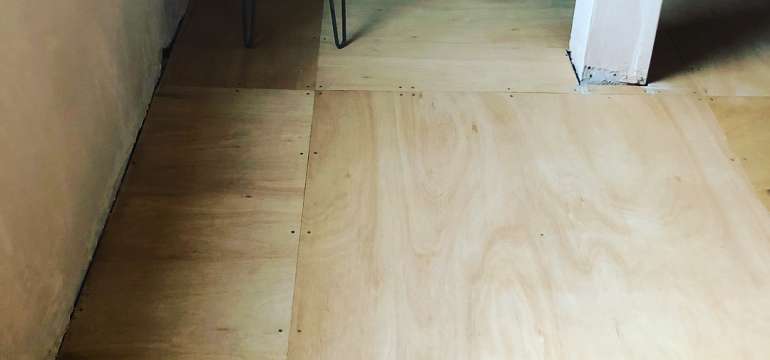Vinyl flooring is a popular choice for bathrooms, kitchens, and laundry rooms due to its easy installation, low maintenance, affordability, and variety of colors. However, because it adheres tightly to the subfloor, any imperfections in the subfloor, like those in unfinished cement, will show on the vinyl surface. To ensure a smooth finish, an underlayment such as Luan flooring is often installed beneath the vinyl.
> Read more: plywood sizes, 3/4 plywood, 4×8 plywood, 1/2 plywood, 5/8 plywood, 1/4 plywood, 1/8 inch plywood, 15/32 plywood, 19/32 plywood, 5x10 plywood
What is Luan Flooring?
What is a luan? What is Lauan? Luan is a type of plywood underlayment material that is approximately ¼ inch thick and typically comes in 4 by 8-foot sheets. It is made from tropical mahogany sourced from the Philippines, which is why it is called “Luan.” The panels are created by layering thin strips of mahogany at right angles and bonding them together under high pressure.
Lauan plywood, commonly known as Luan Plywood, is a term used in the United States to describe a 1/8" to 1/4" tropical hardwood plywood panel. It is typically used for underlayment luan flooring, lamination, paper overlay, furniture, and millwork applications.
Each Luan panel has a smooth side and a rough side. When installing Luan sheets, ensure the smooth surface faces up.
> Read more: laminate flooring, hardwood flooring, baltic birch plywood, maple plywood, ACX plywood, BBOES plywood

Is Luan flooring Different from Plywood?
What is the difference between luan and plywood? Luan is a specific type of plywood. Plywood can be made from various types of wood, including softwood, hardwood, marine wood, and aircraft wood. The properties of plywood vary depending on the type of wood used in its construction.
> Get more details: pine plywood, ac plywood, bamboo plywood, bendable plywood, poplar plywood

What can you use Luan for?
Luan wood, known for its strength and lightweight properties, is versatile and can be used for various applications:
- Interior Doors: Luan is often used to make interior doors due to its strength and ease of handling.
- Ceilings and Walls: Its lightweight nature makes it ideal for use in ceilings and walls, providing structural support without adding much weight.
- Furniture Backing: Luan is commonly used for the backing of furniture, offering support and stability.
- Drawer Bottoms: It is frequently used for drawer bottoms, ensuring a strong base while keeping the furniture piece light.
These applications take advantage of Luan wood's durability and ease of use in construction and furniture-making.
> Discover more: burnt plywood floor, plywood edge banding, plywood garage walls, plywood kitchen cabinets

The typical price for a Luan flooring
The cost of a full sheet of luan varies based on its thickness and the dimensions required. Typically, these sheets are ¼ inch thick and measure 4 feet by 8 feet. For these standard dimensions, the average cost ranges from $0.40 to $0.60 per square foot, amounting to approximately $15 to $20 per sheet.
> Get more details:
- How to remove paint from wood
- How to refinish hardwood floors
- What is plywood made of
- How to Finish Plywood

How to Install Luan Flooring
How to fasten luan to subfloor? To fasten luan to a subfloor, follow these steps:
Tools and Materials Needed:
- Circular saw
- Staple gun
- 1/4 inch crown staples
- Utility knife
- Measuring tape
- Chalk for marking cutting lines
- Subfloor adhesive (if required)
Installation Process:
- Prepare the Subfloor:
- Luan alone is not strong enough to serve as a subfloor. Begin by ensuring that you have a sturdy subfloor in place.
- Lay the First Sheet:
- Start by placing a full sheet of luan in one corner of the room, positioning it perpendicular to the subfloor panels’ direction.
- Maintain a 1/16th inch gap between the Luan flooring and the walls at the corners.
- Secure with Staples:
- Use the staple gun to insert 1/4-inch crown staples every 6 inches across the surface of the luan and 2 inches along the edges.
- Ensure proper spacing to prevent buckling or shifting.
- Install Subsequent Sheets:
- Leave a 1/16th inch expansion gap between each luan panel as you install them in sequence.
- Secure each panel with staples as described earlier.
- Cutting Luan Sheets:
- When cutting Luan flooring, mark cutting lines with chalk.
- Utilize a circular saw for larger cuts and a utility knife for smaller ones.
- Cut from the rough side of the sheet to prevent splintering on the smooth front side.
- Check Staple Placement:
- After installation, ensure that staples are either flush with or below the surface of the luan.
- This prevents protruding staples from interfering with the vinyl flooring installation.
By following these steps, you can properly install luan sheet vinyl flooring for a durable and attractive finish.
> Learn more: birch plywood, MDO plywood, hdo plywood

Why not use Luan as an underlayment?
Luan plywood, while providing a smooth underlayment for flooring, is not water-resistant. It tends to swell and deteriorate when exposed to moisture. Therefore, it’s advisable to use sheet vinyl flooring rather than vinyl tiles over luan underlayment.
What are alternatives to Luan?
RevolutionPly® plywood is an excellent alternative to Lauan and Meranti. It offers uniform color, is easy to cut, sand, and finish, making it ideal for woodworking projects.
Note about Luan flooring
Although luan plywood provides a smooth surface for Luan flooring installation, it lacks water resistance and can swell or degrade when exposed to moisture. For optimal durability, consider installing sheet vinyl flooring rather than vinyl tiles over lauan underlayment.
> Explore further: MDF vs Plywood, Particle Board vs Plywood, OSB and Plywood, plywood ceiling

The above article is VINAWOOD’s sharing about Luan flooring, hope you have more knowledge about this field.
> Learn more:
VINAWOOD – Vietnam Plywood Supplier & Manufacturer









